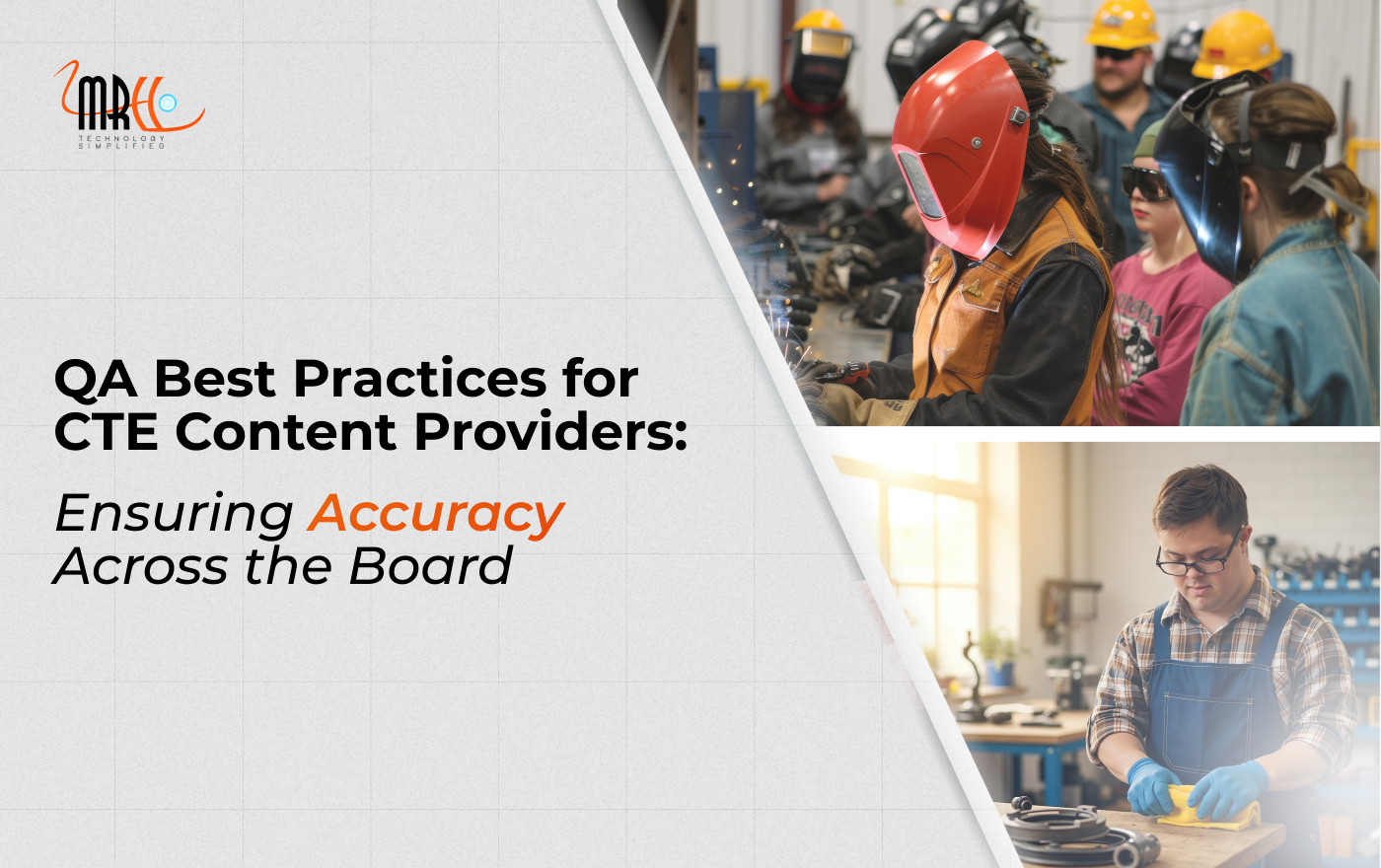Jul 8 2025
QA Best Practices for CTE Content Providers: Ensuring Accuracy Across the Board

VP - Learning Solutions

Jul 8 2025

VP - Learning Solutions

In today’s rapidly evolving educational landscape, Career and Technical Education (CTE) programs are more vital than ever. As per the 2020-21 reports, in the U.S. there were almost 12 million participants in CTE nationwide, including 8.3 million secondary CTE participants and 3.5 million post-secondary participants. The demand for high-quality, accurate, and industry-aligned content is at an all-time high, so there’s no room for error. A single outdated term, a mismatched assessment, or a poorly reviewed module can mean the difference between a student earning an industry certification or failing it. And with millions of students across the U.S. relying on CTE programs for real-world skills, accuracy equals your institution’s success.
But here’s the hard truth: Many CTE content providers overlook quality assurance (QA) until it’s too late.
This blog dives into the QA best practices every CTE content provider must follow to stay competitive, compliant, and credible. We’ll discuss the hidden risks of poor QA, how it impacts funding and student success, and how MRCC EdTech’s targeted QA solutions can safeguard your CTE program in a competitive educational market.
Why QA Matters in CTE Educational Content
CTE programs differ from traditional academic curricula in one critical way: they’re career-aligned and skills-focused. Students use CTE content to acquire job-ready skills, pass industry-standard certifications, and enter directly into the workforce. Any inaccuracies, whether in technical terminology, compliance standards, assessments, or procedures, can lead to misinformation and failure in real-world scenarios.
Here’s why QA assurance is a must-have:
Common Pitfalls in CTE Curriculum QA
Despite good intentions, many CTE institutions fall into recurring quality assurance traps including:
These pitfalls can derail student comprehension and institutional reputation. Avoiding them requires a robust, multi-layered QA process.
The High Stakes of Inaccurate CTE Content
The potential ramifications of inaccurate CTE content are serious, extending beyond academic setbacks to safety risks and compromised professional competence. Inaccurate CTE content accuracy can lead to:
Given these high stakes, implementing rigorous QA best practices for CTE content is not merely an administrative task but a fundamental investment in the success of your students and the integrity of your institution.
Proven QA Best Practices for CTE Content Providers
To meet today’s standards, CTE providers must adopt a well-defined QA framework. Below are seven best practices we recommend:
Before content even goes into review, define quality metrics that reflect CTE learning goals such as NCCER, NIMS, CompTIA, and ASE standards depending on your industry focus.
A good checklist includes:
It’s not enough for content to be technically correct; it also needs to be instructionally sound. Pairing SMEs with trained instructional designers during QA ensures that the material is both accurate and pedagogically effective.
Editorial QA goes beyond catching typos. It evaluates tone, clarity, consistency, and learner appropriateness. Periodic editorial passes, especially during storyboarding and scripting, can prevent rework downstream.
Tools like Grammarly, accessibility checkers, and SCORM testing platforms can automate baseline QA functions and save time. But remember these are complements, not replacements for human judgment.
Create a tiered review system:
This model ensures that content passes multiple layers of scrutiny.
Every quiz, test, and formative evaluation must map directly to a stated learning objective. This ensures instructional integrity and allows for clear measurement of outcomes.
Measure error rates, time to resolution, and revision cycles. Build a feedback system where errors are logged and used to refine future QA processes.
The MRCC EdTech Edge: What Sets Us Apart
In a market flooded with generic QA providers, MRCC EdTech brings a precision-driven approach specifically tailored to the CTE education landscape. Here’s how we stand out:
We don’t offer one-size-fits-all solutions. Our QA teams are trained specifically in CTE curriculum QA including domains like automotive, healthcare, construction, and IT.
With almost three decades in the EdTech and content quality space, we’ve supported hundreds of U.S.-based institutions and educational publishers with scalable, high-impact QA services.
From storyboard validation and editorial QA to SCORM compliance, ADA accessibility, and interactive media reviews, our quality assurance workflows are built to cover every stage of CTE content development.
We align all our QA practices with Perkins V funding requirements, CCSSO guidelines, and state-specific CTE frameworks, ensuring your content is audit-ready and funding-eligible.
Our QA experts come from diverse fields: technical writing, instructional design, accessibility compliance, and media production, enabling a 360-degree review of your educational assets.
Strengthen Your Institution’s Credibility with Expert QA: Partner with MRCC EdTech Experts
The CTE program is a career pathway for millions of students. When accuracy is mission-critical, cutting corners on quality is not an option. Investing in expert QA assurance is a smart, strategic decision for institutions serious about excellence.
And when it comes to QA best practices for CTE content, MRCC EdTech has you covered.
Let MRCC EdTech be your QA partner. We offer flexible, scalable, and cost-effective QA solutions designed to ensure CTE content accuracy across the board. Whether you need editorial QA, instructional design validation, accessibility checks, or full-service QA support, we’re here to help.
Schedule a QA consultation to learn more about how our solutions can enhance your CTE content quality.

Leave A Reply
Your email address will not be published. Required fields are marked *